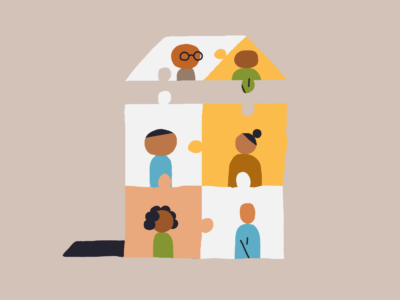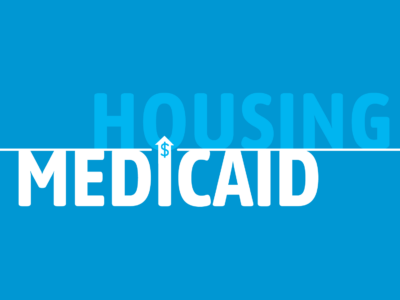Homelessness is a public health crisis. A significant body of literature documents the connection between homelessness and poor mental and physical health for those without safe, affordable, and stable housing. As part of its work to help communities make homelessness rare and brief, Community Solutions has been working to understand how local health departments and health systems can most strategically participate in a cross-sector system that is designed to end homelessness.
In this learning brief, we focus specifically on how embedding medical providers within shelters can increase access to health care and address barriers preventing people experiencing homelessness from engaging in services and receiving care. We have drawn examples from several different communities part of the Built for Zero network and included a toolkit with recommendations and resources for communities to learn how they can embed medical care in shelter spaces.
The challenge: Overcoming structural barriers to health care
Living on the street or in crowded homeless shelters is extremely stressful and made worse by being exposed to communicable disease (e.g., tuberculosis, respiratory illnesses, flu, hepatitis, etc.), violence, malnutrition, and harmful weather exposure. Chronic health conditions such as high blood pressure, diabetes, and asthma become worse because there is no safe place to store medications properly.
In general, people experiencing homelessness must overcome tremendous structural barriers to obtain health care, including lack of health insurance, financial difficulties, and lack of transportation. They must also contend with competing priorities, such as securing food, shelter, and employment, which frequently take precedence over health. People experiencing homelessness may also avoid care because of mistrust of the health care system or negative past experiences like stigmatization and discrimination from providers.
Altogether, these obstacles result in limited access to primary care and non-acute health care services. People experiencing homelessness also utilize inpatient services and emergency departments at higher rates compared to non-homeless individuals. For example, incidents requiring emergency medical services (EMS) for the homeless population in 2018 occurred at a rate of 1155 per 1000 homeless residents, or 14 times the rate of housed residents.
A solution: Providing care within shelters
In order to increase access to healthcare and address barriers that stand in the way, many communities have designed innovative, unique systems to provide care within shelters to individuals experiencing homelessness. Medical providers embedded within shelters can provide low-barrier health care services directly on site. As a result, people experiencing homelessness may be more likely to engage in services and receive more timely care and tailored treatment.
However, each community is different and has its own unique context and needs. As such, any action plan in your community should begin with a strong needs assessment and gaps analysis of your existing care systems and clientele before embedding medical providers in shelters. Further, it is strongly recommended to engage people experiencing homelessness or people with lived experience of homelessness in your decision-making and needs assessment.
Built for Zero Community Examples
In Anchorage, Alaska, guests at their largest shelter have access to The Caring Clinic, which “provides free access to preventative care and treats acute illnesses, wound acute illnesses, wound care & skin infections, laceration repair, injuries, cough/colds/flu, sore throats, and more.” The Clinic focuses on primary and urgent care but also has the ability to order and distribute prescriptions daily.
The Southcentral Foundation provides staffing (a physician’s assistant and support staff) and support to Catholic Social Services, which runs the day-to-day shelter operations. The Caring Clinic staff have the ability to escalate any health care issues that cannot be treated in-house, including mechanisms to refer patients to follow-up care, emergency services, or specialists.
“One key understanding is that one person’s health journey requires a lot of changing lanes as they have different needs,” said Dave Rittenberg, Sr. Director of Adult Homeless Services at Catholic Social Services Alaska. “It’s crucial for us to understand where the Clinic’s lane ends and another provider’s begins. There’s some criss-cross, but we’re working on it.”
Historically, the Clinic and Catholic Social Services maintain a relationship with the local health department to partner on programs such as flu and tuberculosis clinics or infectious disease mitigation and prevention. As the Covid-19 pandemic winds down, there remains opportunity to build upon this relationship with sustainability in mind.
Through targeted, preventative care, clinic staff aim to reduce calls for emergency services, emergency department visits, and eliminate the barriers to access that prevent many individuals from seeking health care. Although it remains early, the initial results are promising: According to Catholic Social Services Alaska, in the first year of providing transportation, Brother Francis Shelter spent $50,000 on cab fares for guests to and from hospitals and medical appointments, saving the city $500,000 in prevented EMS calls.”
Throughout the country and the Built for Zero network, there are additional varied examples of successful programs that embed medical care in shelter spaces.
- Fairfax, Virginia’s Local Health Department provides four nurse practitioners that work in shelters for people experiencing homelessness. Their role is to serve as care coordinators and connect people that utilize the shelter to local health care providers.
- The Boston Health Care for the Homeless Program aims to provide accessible health care for people experiencing homelessness and prioritizes meeting people on their own terms. Primary care physicians see patients at a brick-and-mortar clinic called Jean Yawkey Place, and also work in shelters across the city, in respite care programs, and on the streets for people experiencing unsheltered homelessness in need of primary and behavioral health care.
- The Hennepin County Health Department supports a team that manages nine clinics in shelters (and drop-in centers), which include a 24-hour medical respite shelter, a large family shelter, and other important services.
Community Toolkit
Our goal with the information below is to provide actionable tools and resources that would allow your community to launch a health and homelessness program.
Click the header below to expand to that section.
Rationale
People experiencing sheltered homelessness are vulnerable to exposure to communicable disease (e.g. tuberculosis, respiratory illnesses, flu, hepatitis, etc.), violence, malnutrition, and harmful weather exposure. Chronic health conditions such as high blood pressure, diabetes, and asthma become worse because there is no safe place to store medications properly. Homeless populations often engage with local emergency medical services as a means of care. In fact, a study in Los Angeles found that “Incidents requiring Emergency Medical Services for the homeless population occurred at a rate of 1,155 per 1,000 homeless residents or 14 times the rate of housed residents.”
With significant risks such as those above, health outcomes for sheltered homeless require unique and specific focus. For example, a New York City study on the mortality rates of homeless during the Covid-19 pandemic found that the mortality rate for sheltered homeless New Yorkers was 49 percent higher than the general population. Further, studies indicate that the mortality rate of homeless adults is 2.3 times that of the overall adult population.
Potential Funding Sources
CDC Workforce Strategy Fund: In late 2022, CDC awarded OE22-2203: Strengthening U.S. Public Infrastructure, Workforce, and Data Systems grant. As a component of this grant, health workforce strategy funds can be used for homeless-related workforce needs and added capacity to public health teams.
Foundations/Philanthropy: Often, funding for ventures in public sectors comes from foundations, and there are institutions that focus their gifting on strategic areas, including health care, public health, and homelessness. Explore local community foundations that might have upcoming goals or programs around health and homelessness.
Partnerships with local health systems: Local health and hospital systems often collaborate with community members and organizations as they plan the distribution and use of funds in their community benefit grants.
Implementation
Best Practices for Shelter-Based Care
Based on many years of experience working in shelters and other outreach sites to provide health care to people experiencing homelessness, here are some lessons that care providers have learned about best practices for delivering shelter-based care.:
- Highlight the importance of follow-up.
- Integrate trauma-informed care.
- Recognize the necessity of community collaborations.
- Mitigate fear and shame.
- Focus on stories.
- Meet clients where they are.
Healing Hands: Shelter-Based Care for Homeless Populations
Where could you start?
The National Health Care for the Homeless Coalition highlights a few key considerations when exploring this type of care:
First, structure is important, not just in terms of your program but also in terms of licensure. In fact, a recent search for coalition member examples where shelters directly employed medical personnel found in each instance the medical staff were not direct employees of the shelter but instead were contractors.
Instead, NHCHC found that the most common method for shelters to provide access to medical services onsite was to partner with health care agencies and/or their local health department.
Lastly, in any planning, it’s paramount to decide on the type of service you want to provide. One avenue to explore here is to engage with local people with lived experience of homelessness or look at aggregate data from health care partners about their patient population (ideally those identified as homeless). Look for trends in what department or service is most commonly sought out or required and explore services that might help these individuals most.
For example, if your data and interviews highlight that individuals experiencing homelessness often remain in hospitals after surgeries or procedures because there is a lack of recuperative care facilities, that might be the top need for your community.
For example, if your data and interviews highlight that wound care is a common need of patients experiencing homelessness and that last month there were 28 EMS calls related to wounds, perhaps the priority for your shelter should be a localized, trusted clinic that accepts walk-in patients, especially for wound care.
Outcomes & Evaluation
The evaluation of shelter clinic programs varies on the scope and service delivery model, but there are some high-level indicators that can be powerful demonstrations of the program’s impact. Although the below examples are just a starting point, additional measures could be drafted in conversations between the local health department, health system, and shelter staff (or Continuum of Care).
- Reductions in EMS visits (for sheltered adults)
- Reductions in ER visits (for sheltered adults)
- Improved relationships and trust between providers & patients
- Number of clients connected to care plans
- Number of clients referred to other service providers or care coordinators
Acknowledgement
Anchorage, Alaska, is a participating community in the Healthcare and Homelessness Pilot, a three-year initiative, operated by Community Solutions and the Institute for Healthcare Improvement, in partnership with several major health systems — Kaiser Permanente, Providence Health, CommonSpirit Health, UC Davis Health, and Sutter Health.




